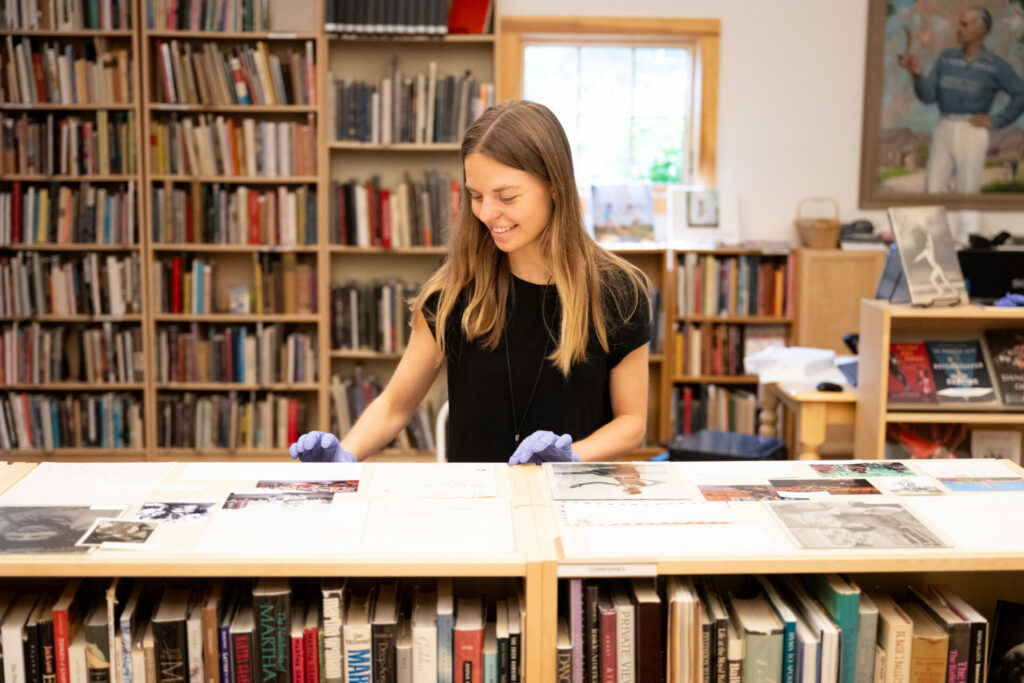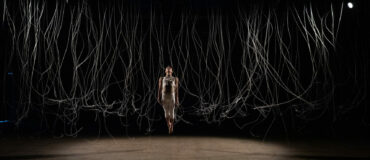By Isabel Brandt
Isabel Brandt is a 2024 Archiving and Preservation Fellow with Dianne Walker. Read more about the Fellowships here. This is the third part of Isabel’s blog. Read the second part here.
Preserving Community

Dianne Walker and students on stage for the 2nd Annual Dance Performance of Leon Collins Dance Studio, produced by Dianne Walker. June 26th, 1982 in Brookline, Massachusetts.
By August, my time with Dianne was coming to an end. The disorganized collection of papers, photos, and tapes I had first encountered in May was now carefully boxed, shelved, and cataloged for easy access. The bulk of the work was complete, and the Dianne Walker archives had been successfully compiled. The materials documenting her illustrious career were now findable via an inventory spreadsheet. In those final weeks at Dianne’s home, I focused on categorizing remaining items, labeling boxes and folders, and reflecting on the next steps for the collection.
The final week of the Fellowship coincided with the Dance/USA Archiving and Preservation Fellowship Program Cohort Convening in Detroit. This convening brought together the four Fellows, the four artist groups, additional team members and representatives, and Hallie Chametzky, the force behind the Fellowship Program and the Archiving and Preservation department of Dance/USA. Aside from a few Zoom check-ins with the other Fellows throughout the summer, this convening was the primary opportunity to discuss, debrief, and aspire towards the future of our preservation work.

• Dianne Walker and Jimmy Slyde on the set of the movie Tap, 1988.
During our first meeting, introductions quickly turned into inspiring conversations with artists who shared a common goal: preserving their legacies. Although each artist group came from different disciplines and experiences, our goals converged, and connections formed effortlessly. The discussions were both practical and thought-provoking. We explored the unique challenges of archiving dance, from limited funding to the inherent ephemerality of the form. Themes of Indigenous and non-Eurocentric practices emerged, offering alternative models better suited to the creative, transient nature of dance materials. We also exchanged practical insights on topics like digital asset management systems, realistic digitization methods, outreach strategies, and digital interfaces for showcasing archives. As these discussions unfolded, I began to gain clarity on the future of the Dianne Walker archives. I considered how her collection could be incorporated into her foundation’s website, expanding its reach and accessibility.

Final arrangement and labeled boxes of the Dianne Walker archives. (Boston, MA)
One of the key topics during the cohort convening in Detroit was the question of where Dianne’s collection should ultimately reside. With her collection now organized and inventoried, the next major step is determining its permanent home. During the convening, we visited two different archival spaces: the Walter P. Reuther Library at Wayne State University (including the Michigan Dance Archives) and the Detroit Sound Conservancy. Since a university repository has been the leading option for Dianne’s collection, it was invaluable to learn how such institutions operate, how collections are used for university-wide research and beyond, and how materials are cared for and maintained. Seeing the vast collections held at Wayne State and their deep ties to the community was both eye-opening and inspiring. It helped Dianne and me envision how Dianne’s collection could be preserved and utilized for years to come.

Stacks of the Wayne State University Archives (Detroit, MI)
On the other hand, our visit to the Detroit Sound Conservancy introduced us to a different kind of archival space—a community archive. Unlike a traditional institutional repository, the Conservancy’s community-based, artistic practice made it feel more personal and connected to the culture it serves. While the Conservancy faces its own challenges as a nonprofit, its dedication to telling untold stories within the community was palpable. The passion of the lead archivist, who began the project by preserving her husband’s legacy, was inspiring. It reminded me of Dianne, the tap community, and the deeply rooted lineage and sense of belonging that defines it.
Both archives offered insight into different ways of preserving collections, each with their own strengths. Wayne State, with its deep resources and ties to academic research, represented the institutional approach. The Detroit Sound Conservancy, with its grassroots origins, felt more like a living, breathing archive, deeply connected to the community it served.

Left to right: Isabel Brandt, Dianne Walker, and Lia Spirka during the trip to Detroit for the Fellowship Convening.
I couldn’t help but think of Dianne’s collection in this context. Would a university archive be the right place, giving her story the space and longevity it deserved, or would a more community-centered space, connected to the tap world she’s so much a part of, offer a more fitting home? The tap community has always thrived on connection, mentorship, and shared history—it’s a lineage passed down through generations, often outside of institutions. In a way, preserving that sense of community feels just as important as practical archival preservation.
All photos courtesy of Dianne Walker or Isabel Brandt.
Header image: Left to right: Bernard Manners, Dianne Walker, Melvin Washington, Ivery Wheeler backstage for the production of Black and Blue – Théâtre du Châtelet, Paris, France, 1985.

Isabel Brandt is currently pursuing a Master’s Degree in Library and Information Science at Pratt Institute with a focus in archival studies. She received her BFA in Dance from The Ohio State University through which she pursued several research projects exploring the process of dance archiving and reconstruction. As an Undergraduate Library Research Fellow, Isabel conducted archival research and created a guide to unprocessed dance scores in the Dance Notation Bureau Collection to explore digital librarianship with dance notation. In 2022, she presented her research abroad to an international community of dance archivists and researchers at the conferences of the International Council of Traditional Music (ICTM) and the International Council of Kinetography Laban (ICKL). As an Archives and Audience Engagement intern with Jacob’s Pillow Dance Festival, Isabel furthered her expertise in archival reference, exhibition development, finding aid cataloging, and archival processing. Isabel is drawn to the unique, collaborative, and creative nature of dance archiving and is excited to explore how the archivist role can center artistic voice and identity.
Photo credit: Christopher Duggan
____
We accept submissions on topics relevant to the field: advocacy, artistic issues, arts policy, community building, development, employment, engagement, touring, and other topics that deal with the business of dance. We cannot publish criticism, single-company season announcements, and single-company or single artist profiles. Additionally, we welcome feedback on articles. If you have a topic that you would like to see addressed or feedback, please contact communications@danceusa.org.
Disclaimer: Opinions expressed in guest posts do not necessarily represent the viewpoints of Dance/USA.






